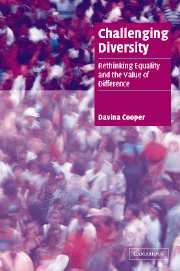Book contents
- Frontmatter
- Contents
- Acknowledgments
- 1 Introduction: mapping the terrain
- 2 Diversity politics: beyond a pluralism without limits
- 3 From blokes to smokes: theorising the difference
- 4 Towards equality of power
- 5 Normative encounters: the politics of same-sex spousal equality
- 6 Getting in the way: the social power of nuisance
- 7 Oppositional routines: the problem of embedding change
- 8 Safeguarding community pathways: ‘possibly the happiest school in the world’ and other porous places
- 9 Diversity through equality
- Bibliography
- Index
- Cambridge Cultural Social Studies
1 - Introduction: mapping the terrain
Published online by Cambridge University Press: 22 September 2009
- Frontmatter
- Contents
- Acknowledgments
- 1 Introduction: mapping the terrain
- 2 Diversity politics: beyond a pluralism without limits
- 3 From blokes to smokes: theorising the difference
- 4 Towards equality of power
- 5 Normative encounters: the politics of same-sex spousal equality
- 6 Getting in the way: the social power of nuisance
- 7 Oppositional routines: the problem of embedding change
- 8 Safeguarding community pathways: ‘possibly the happiest school in the world’ and other porous places
- 9 Diversity through equality
- Bibliography
- Index
- Cambridge Cultural Social Studies
Summary
Nonsmokers living in condominiums and apartment buildings who are bothered or made ill by drifting tobacco smoke can now fight back … These dangerous chemicals can … seep in above or below an apartment door, through poorly sealed walls, and in many other ways … More and more tenants are filing effective complaints – often with information provided by Action on Smoking and Health (ASH), the nation's oldest and largest antismoking organization.
Are you involved in a dispute over custody, and your spouse smokes in the presence of the child … If so, you should read ASH's preliminary report on custody and smoking. In it you will learn that, in more than a dozen states, courts have ruled that whether or not a child is subjected to tobacco smoke is a factor which should be considered in deciding custody.
In the 1990s, across several continents, battles over cigarette smoking took on a new momentum, as pro- and anti-smokers fought over institutional policy-making, local, state and federal laws, and the ethics of intervention and restraint. Tobacco advocates declared that smokers had become the new oppressed, smoking the new apartheid. Discriminated against in job interviews and healthcare, banished from particular spaces and disproportionately taxed, smokers were on the receiving end of an intensifying attack and stigmatisation. As one tobacco advocate declared, ‘We are at a crossroads. We as a people are beginning to see what is produced by state-sponsored intolerance of “target groups”.’
- Type
- Chapter
- Information
- Challenging DiversityRethinking Equality and the Value of Difference, pp. 1 - 14Publisher: Cambridge University PressPrint publication year: 2004



